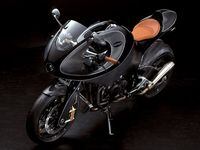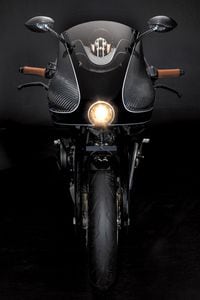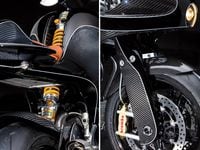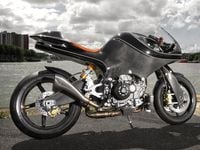Carbon fiber has become something of a cliché. All too often it evokes visions of fake, stick-on finishes or chintzy bolt-on accessories. But the material’s use on the new Dutch firm VanderHeide’s blacked-out creation is in an altogether different class. It’s everywhere, replacing metal wherever imaginable. In a world where there’s a wide choice of 200-hp superbikes at everyman prices, performance alone is no longer justification for a handmade exotic. But by bucking every convention, VanderHeide is out to earn every cent of its $165,000 price tag.
The vast majority of the bike is a single, massive carbon-fiber piece. From the single headlight to the very tip of the tail, the bike’s main feature is a monocoque that makes up its fairing, chassis, and fuel tank. It’s molded in one section, to which the engine and suspension are bolted to create the finished bike. While we’re talking about suspension, the fork and swingarm are completely carbon fiber.
At the back there's a fairly conventional swingarm, allied to an Öhlins TTX36 shock. Up front things get a little less usual: A carbon, Hossack-style girder fork is mounted on double wishbones, similar to a BMW Duolever setup. Unlike a BMW, the front shock isn't fitted near the steering head but is instead set into the rear of the fuel tank and operated via a rocker-and-pushrod system a bit like a single-seat racing car's suspension.
Again, the shock is an Öhlins TTX36 unit. Completing the carbon-fiber theme, the wheels are BST carbon five-spokes. Basically, the rule seems to have been that if it can be made of carbon, it will be made of carbon.
The result is a bike that's lightweight at 386 pounds dry without being stripped back to racer levels. This isn't a track-only GP replica but a road bike that's intended to push the same buttons as exotic supercars like a Bugatti or Pagani. The bars are wide, ending in luxurious leather grips that match the single seat—not that they need to. As you would expect on something so bespoke, all the choices of finish and trim material will be chosen by individual buyers.
What powers all this? As you might have spotted, the engine is an out-of-the-crate Aprilia RSV4 mill. With 201 hp in stock, catalyzed, road-legal form, it's among the most compact and powerful motors that the firm could choose, and since it carries over the Aprilia electronics, emissions aren't a problem. Optionally, buyers will be able to opt for a track-only version using a WSBK-spec 230 hp version of the engine, minus the emissions controls. Either way, a race-style Motec full-color dash tells you everything you need to know about how and what the engine is doing.
Impressively, the VanderHeide appeared from nowhere as a fully formed running bike with production plans already in place. It was revealed to the public at the Goodwood Festival of Speed in June (see sidebar) but is actually the result of five years’ hard work by a pair of brothers who give it its name: Rolf and Sjors Van der Heide.
Sjors takes up the tale: “It’s my brother Rolf’s story really. Our father is a motorcyclist, and as long as we remember we’ve always wanted to ride them and to build one. Rolf has an engineering background; I have a business administration background. He does all the hand working; I do the talking. That’s the combination.
“It all started five years ago in 2011 when Rolf decided to build his own bike. Before that he worked with Spyker, the supercar brand, and with Carver [the Dutch firm that made a strange, leaning three-wheeled car]. After that he specialized in carbon fiber.
“In 2011 he decided to combine his knowledge and experience into building his own bike. There were two main ideas. First was to use carbon fiber as the base material, and second was to use his own suspension system because he was never really pleased with telescopic forks.
“We invited Michiel van den Brink, who’s a Dutch car designer, to be responsible for the styling of the bike, and step by step Rolf started building. It took a long time because there was a lot of pioneering involved. You may have noticed there are a lot of organic, curved shapes, and that’s pretty complicated to design and produce. And then there’s the monocoque chassis, which is really one piece of carbon fiber. It has three functions: It’s the stressed member of the frame, it’s the fuel tank, and it’s the fairing. So we spent quite some time pioneering the engineering and working out all the details to make sure that everything is safe.”
While the bike’s suspension technology isn’t conventional, the girder forks are a proven concept, though the front shock position is unconventional. “There’s a carbon-fiber front end with a double-wishbone construction,” Sjors says, “linked by a pushrod and a rocker to the Öhlins front damper. We’re used to considering these as rear shocks, but we use them both for front and rear. We position them in line and in opposite directions, so they compensate and eliminate the opposing forces. That reduces stress on the chassis.”
You’ll also notice that the radiator is at the “wrong” end of the bike—it sits under the seat. But like the front suspension, that’s the result of some joined-up thinking. The carbon monocoque allows for air to be channeled through the body/chassis unit and to reach the radiator at the back. “This is the most efficient way to position the radiator,” Sjors articulates. “The air comes in at the front and it flows in a straight line via the engine and through the radiator. There is a fan, too, and as far as we have tested it, the position works just fine. The airflow works as we expected.”
Sjors is also confident that riders who grew up around conventional suspension will find the bike’s front end to be a pleasant surprise. “We are in this ‘funny front end’ category,” he says, “I don’t really like the label, but that’s how people approach it because there’s no telescopic fork. The most interesting thing about this suspension is that we can adjust it any way you like. So we can give you dive and replicate the traditional telescopic feel. We can give you anti-dive, like a hub-steer construction, because we separate the braking and suspension forces. We can even give you extra anti-dive, which would mean the front end will go up under braking. We wanted to include all the front-end feel options to give people the opportunity to adapt to this sort of front end.”
As for full production, the brothers didn’t quite come out of nowhere. At the moment, the bike is in the pre-production stage, but the brothers expect to be able to move fairly quickly to building customer machines. They’ve already built facilities to make the most complex element, the carbon monocoque. Sjors explains: “There’s no autoclave in Holland big enough to house these molds. So we have an oven, which we built ourselves. The resin is vacuum-injected and then it’s put in the oven, which is how the carbon fiber is dried.
"We are accepting pre-orders. We have an arrangement with Aprilia for the engine supplies and can even mount the superbike engine—the 230-horsepower engine—but then the bike won't be street-legal anymore. The bike we have introduced at Goodwood is the street-legal version, with the catalytic converter, licence plate, and everything. As soon as we have the necessary production facilities, we expect to be able to produce a bike in two to four weeks."
While the price starts at 150,000 euros, each bike will be different and priced to reflect the customer’s choices. Sjors explains: “We can tailor make the bike to a customer’s needs. We will measure the length of their legs and everything. They can choose the color, they can choose to mount the superbike engine—so they can choose either a street-legal or a racetrack edition.”
So, really, what are you waiting for? One of the best motorcycle engines for sale today, bolted to an exquisite and exotic chassis, cut to fit you perfectly—if only you could pay in drool.
The unveiling of the finished VanderHeide at the Goodwood Festival of Speed wasn’t just a surprise to the visitors—even the organizers weren’t expecting it! Sjors Van der Heide says the brothers gambled on getting entrance to one of the most exclusive motorsport events in the world purely on the basis of the bike’s stunning appearance and engineering.
“The Goodwood introduction was really a stunt,” Sjors said. “We weren’t invited. We finished the bike on the Monday before the festival, on the Tuesday we had a photo shoot in the studio, and on Wednesday we set off for Goodwood. On Thursday we knocked at the gate and asked them to let us in. They said no because we didn’t have an invitation and the motorcycle paddock was fully booked. But we managed to meet the right people, and eventually we were invited, on the spot, to the event. The other participants in the motorcycle paddock had to move to make space for us. They were very kind to us.”
The brothers will be back at Goodwood next year. This time, they’ve been invited.










/cloudfront-us-east-1.images.arcpublishing.com/octane/EX4FYIWEFKNAARW6IFJQG4UIGE.jpg)





/cloudfront-us-east-1.images.arcpublishing.com/octane/VZZXJQ6U3FESFPZCBVXKFSUG4A.jpg)
/cloudfront-us-east-1.images.arcpublishing.com/octane/QCZEPHQAMRHZPLHTDJBIJVWL3M.jpg)
/cloudfront-us-east-1.images.arcpublishing.com/octane/HXOUJXQWA5HBHGRO3EMJIGFMVI.jpg)

/cloudfront-us-east-1.images.arcpublishing.com/octane/3TIWWRV4JBBOLDVGRYECVVTA7Y.jpg)
/cloudfront-us-east-1.images.arcpublishing.com/octane/KIX5O23D5NAIBGFXBN3327DKZU.jpg)
/cloudfront-us-east-1.images.arcpublishing.com/octane/7GJYDUIPXRGMTMQKN6ONYOLBOU.jpg)
/cloudfront-us-east-1.images.arcpublishing.com/octane/MUQLOVLL2ZDGFH25ILABNBXKTI.jpg)
/cloudfront-us-east-1.images.arcpublishing.com/octane/TNOU5DNE2BC57MFPMGN2EIDXAM.jpg)
/cloudfront-us-east-1.images.arcpublishing.com/octane/GTCXACQGJ5HAPDTGWUQKDEH44E.jpg)
/cloudfront-us-east-1.images.arcpublishing.com/octane/S35YGSEMEZB4BLTDJTSZPF4GLA.jpg)
/cloudfront-us-east-1.images.arcpublishing.com/octane/5UOT6HPX2JFMRJAX6EH45AR4MQ.jpg)
/cloudfront-us-east-1.images.arcpublishing.com/octane/OKWOJWAKP5EP3OACCRRWPCIX2Q.jpg)
/cloudfront-us-east-1.images.arcpublishing.com/octane/2WF3SCE3NFBQXLDNJM7KMXA45E.jpg)
/cloudfront-us-east-1.images.arcpublishing.com/octane/G4MG6OUCJNBSHIS2MVVOTPX65E.jpg)
/cloudfront-us-east-1.images.arcpublishing.com/octane/IIGGWFOTOJGB7DB6DGBXCCMTDY.jpg)
/cloudfront-us-east-1.images.arcpublishing.com/octane/QSTCM6AVEZA5JJBUXNIQ3DSOF4.jpg)
/cloudfront-us-east-1.images.arcpublishing.com/octane/U4I7G625B5DMLF2DVIJDFZVV6M.jpg)
/cloudfront-us-east-1.images.arcpublishing.com/octane/B6XD6LS6IVCQPIU6HXDJSM3FHY.jpg)
/cloudfront-us-east-1.images.arcpublishing.com/octane/ICL63FEDDRDTTMINYICCEYGMDA.jpg)
/cloudfront-us-east-1.images.arcpublishing.com/octane/FCGZHQXRBZFLBAPC5SDIQLVF4I.jpg)
/cloudfront-us-east-1.images.arcpublishing.com/octane/WNOB6LDOIFFHJKPSVIWDYUGOPM.jpg)

/cloudfront-us-east-1.images.arcpublishing.com/octane/X33NU3E525ECRHXLNUJN2FTRKI.jpg)